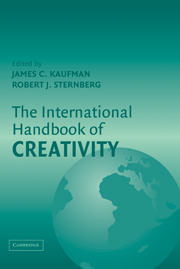Book contents
- Frontmatter
- Contents
- Acknowledgments
- List of Contributors
- 1 Introduction
- 2 Creativity Research in English-Speaking Countries
- 3 Creativity in Latin America
- 4 History of Creativity in Spain
- 5 Past, Present, and Future Perspectives on Creativity in France and French-Speaking Switzerland
- 6 Creativity in Italy
- 7 Creativity Research in German-Speaking Countries
- 8 Creativity Under the Northern Lights
- 9 Creativity in Soviet–Russian Psychology
- 10 Creativity Studies in Poland
- 11 Research on Creativity in Israel
- 12 Creativity in Turkey and Turkish-Speaking Countries
- 13 Development of Creativity Research in Chinese Societies
- 14 Creativity – A Sudden Rising Star in Korea
- 15 Culture and Facets of Creativity
- 16 African Perspectives on Creativity
- 17 Creativity Around the World in 80 Ways … but with One Destination
- Author Index
- Subject Index
- References
15 - Culture and Facets of Creativity
The Indian Experience
Published online by Cambridge University Press: 05 June 2012
- Frontmatter
- Contents
- Acknowledgments
- List of Contributors
- 1 Introduction
- 2 Creativity Research in English-Speaking Countries
- 3 Creativity in Latin America
- 4 History of Creativity in Spain
- 5 Past, Present, and Future Perspectives on Creativity in France and French-Speaking Switzerland
- 6 Creativity in Italy
- 7 Creativity Research in German-Speaking Countries
- 8 Creativity Under the Northern Lights
- 9 Creativity in Soviet–Russian Psychology
- 10 Creativity Studies in Poland
- 11 Research on Creativity in Israel
- 12 Creativity in Turkey and Turkish-Speaking Countries
- 13 Development of Creativity Research in Chinese Societies
- 14 Creativity – A Sudden Rising Star in Korea
- 15 Culture and Facets of Creativity
- 16 African Perspectives on Creativity
- 17 Creativity Around the World in 80 Ways … but with One Destination
- Author Index
- Subject Index
- References
Summary
Sa vai naiva reme, tasmādekākī na ramate.
Sa dwitiyamaichata.
[He did not enjoy himself alone.
He desired – I am alone, let me have a second one.]
– Brhadāranyaka Upanishad, 4.3Apāre kāvyasamāre kavirekah prajāpatih
Yathāsmai rochate viswam tathetadparivartate
[In the endless world of poetry the poet is the only Creator and he shapes this world, as he likes.]
– Anandvardhan (1975; Dhvanyaloka Commentary on 3.42)INTRODUCTION
It is often believed that creativity is demonstrated when we indulge in contributing something original or novel and useful to the domains of objects and ideas. Thus any creation, irrespective of its domain, is deemed “creative” to the extent that it is different from earlier creations and has functional value (Runco, 2004; Sternberg & Lubart, 1996). In this way, creativity challenges tradition, questions the status quo, and brings in change and innovation. At the same time, the flexibility introduced by creativity empowers people to act more effectively in relation to self as well as environment.
Since creativity involves originality and novelty, it is sometimes considered to be a gift of God, but discoveries and inventions clearly imply the role of human effort. In fact, creativity is paradoxical in many respects and defies any simple characterization. Creativity is often conceptualized as a general human ability, but its apparent recognition in different areas suggests the need to accommodate diverse creative talents. Similarly, while it is related to intelligence, highly intelligent people are not necessarily highly creative.
- Type
- Chapter
- Information
- The International Handbook of Creativity , pp. 421 - 455Publisher: Cambridge University PressPrint publication year: 2006
References
- 28
- Cited by



